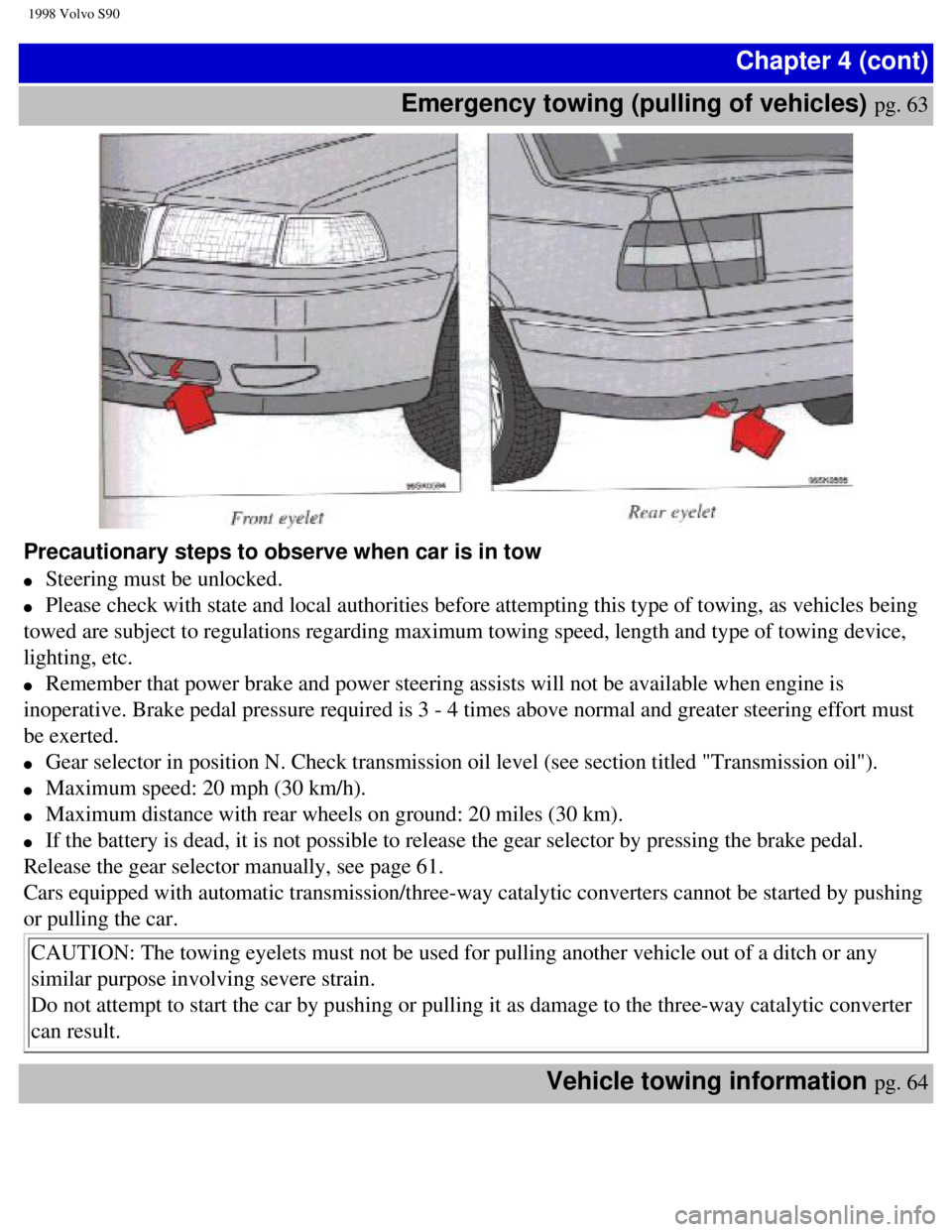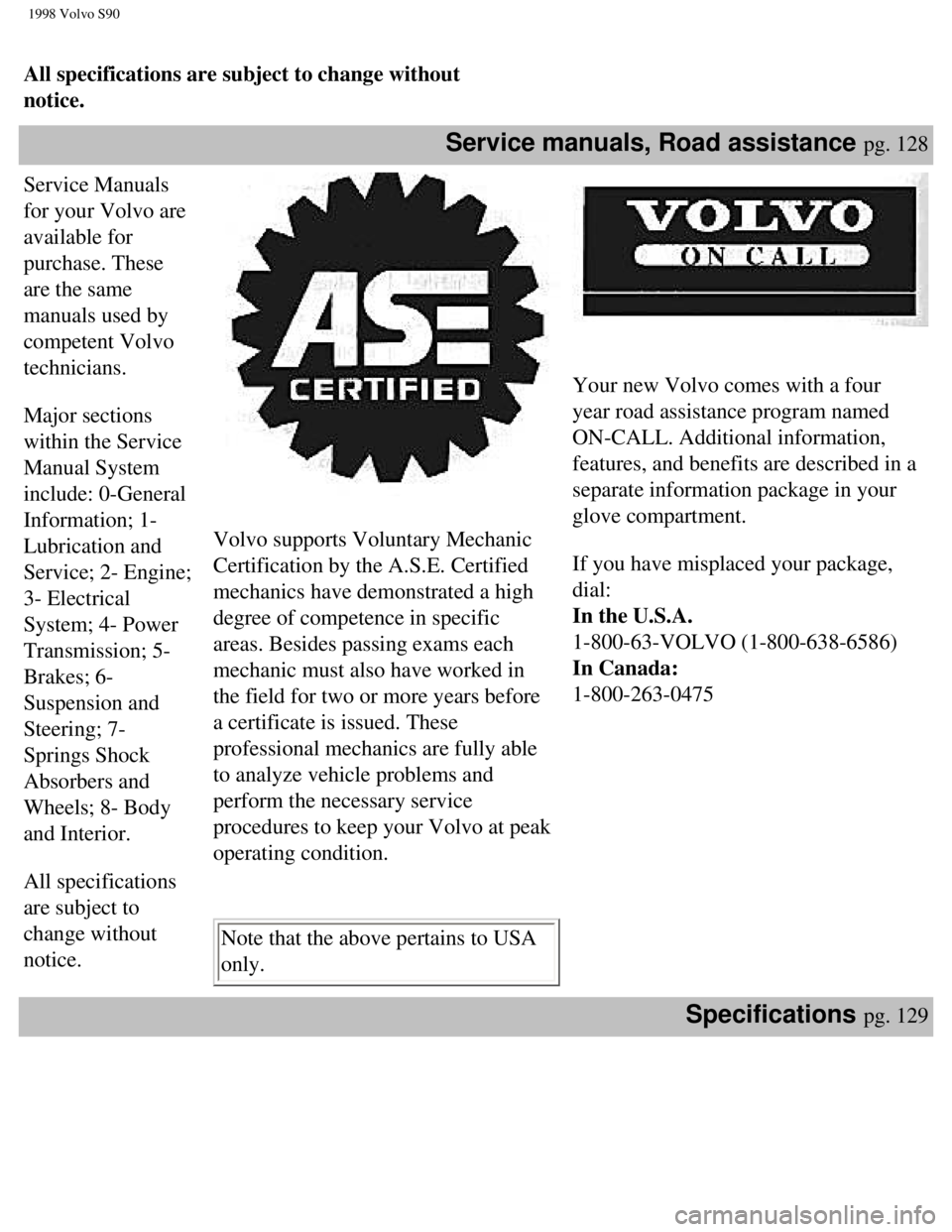1998 VOLVO V90 steering wheel
[x] Cancel search: steering wheelPage 71 of 175

1998 Volvo S90
disconnected, the code must
be re-entered before the radio
will function properly.
Points to remember pg. 62
Weight distribution affects
handling
At the specified curb weight
your car has a tendency to
understeer, which means that the
steering wheel has to be turned
more than might seem
appropriate for the curvature of
a bend. This ensures good
stability and reduces the risk of
rear wheel skid. Remember that
these properties can alter with
the vehicle load. The heavier the
load in the trunk, the less the
tendency to understeer.
Handling, roadholding
Vehicle load, tire design, and
inflation pressure, all affect
vehicle handling. Therefore,
check that the tires are inflated
to the recommended pressure
according to the vehicle load.
See "Tire pressure" section.
Loads should be distributed so
that capacity weight or
maximum permissible axle loads
are not exceeded.
WARNING!
An extra mat on the driver's
floor can cause the
accelerator pedal to catch.
Check that the movement of
the accelerator pedal is not
impeded. Not more than one
protective floor covering may
be used at one time.
CAUTION: Drive slowly and
carefully if going through
standing water (i.e. flooded
roadways, etc.). Damage to
engine could result if excess
water is ingested through the air
intake system. Never drive the
vehicle in water deeper than 1
foot (300 mm). See the flood
warning on page 7.
WARNING! Do not drive
with trunk lid or tailgate
open!
Poisonous exhaust gases may
enter via the trunk lid or
tailgate.
If the trunk lid/tailgate must
be kept open for any reason,
proceed as follows:
l Close the windows.
l Set the ventilation system
Roof rails/racks
Roof rails are standard
equipment on wagon models.
Load bars are available as a
retailer installed option on the
sedan models. Observe the
following points when is use:
l Avoid single-point loads.
Distribute the load evenly.
l Place heavier cargo at bottom
of load.
l Observe that center of gravity
and handling are influenced by
load weight.
l Increasing load size increases
wind resistance and, thus,
adversely affects fuel economy.
l Anchor the cargo correctly
with appropriate tie-down
equipment.
l Drive carefully. Avoid rapid
starts, fast cornering and hard
braking.
l Max. roof load is 220 lbs.
(100 kg) for removable racks.
For permanent roof racks, check
the manufacturers weight
specifications.
file:///K|/ownersdocs/1998/1998_SV90/98S90_058.htm (6 of 7)12/30/2006 \
1:52:42 PM
Page 73 of 175

1998 Volvo S90
Chapter 4 (cont)
Emergency towing (pulling of vehicles)
pg. 63
Precautionary steps to observe when car is in tow
l Steering must be unlocked.
l Please check with state and local authorities before attempting this typ\
e of towing, as vehicles being
towed are subject to regulations regarding maximum towing speed, length \
and type of towing device,
lighting, etc.
l Remember that power brake and power steering assists will not be availab\
le when engine is
inoperative. Brake pedal pressure required is 3 - 4 times above normal a\
nd greater steering effort must
be exerted.
l Gear selector in position N. Check transmission oil level (see section \
titled "Transmission oil").
l Maximum speed: 20 mph (30 km/h).
l Maximum distance with rear wheels on ground: 20 miles (30 km).
l If the battery is dead, it is not possible to release the gear selector \
by pressing the brake pedal.
Release the gear selector manually, see page 61.
Cars equipped with automatic transmission/three-way catalytic converters\
cannot be started by pushing
or pulling the car.
CAUTION: The towing eyelets must not be used for pulling another vehicle\
out of a ditch or any
similar purpose involving severe strain.
Do not attempt to start the car by pushing or pulling it as damage to th\
e three-way catalytic converter
can result.
Vehicle towing information pg. 64
file:///K|/ownersdocs/1998/1998_SV90/98S90_063.htm (1 of 4)12/30/2006 \
1:52:43 PM
Page 80 of 175

1998 Volvo S90
cold-weather oil for hard driving or in warm
weather. See section "Engine oil" for more
information.
l The load placed on the battery is greater during
the winter since the heater, windshield wipers,
lighting etc. are used more often. Moreover, the
capacity of the battery decreases as the
temperature drops. In very cold weather, a poorly
charged battery can freeze and be damaged. It is
therefore advisable to check the state of charge
more frequently and spray an anti-rust oil on the
battery posts.
l Volvo recommends the use of snow tires on all
four wheels for winter driving - see section
"Wheels and tires".
l To prevent the washer reservoir from freezing,
add washer solvents containing antifreeze. This is
important since dirt is often splashed on the
windshield during winter driving, thus requiring
frequent use of the washers and wipers.
functions when the transmission is in reverse.
Also see "Winter/Wet" mode on page 59.
Winter/Wet mode
Enhanced Vehicle Traction
This mode may be selected for starting/moving
off on slippery roads or to lower downshift speeds
if the transmission is in "L".
Mode W
*In position D, the gearbox starts in third gear and
changes up to fourth gear.
*In position 3, second gear is locked and there is
no change up to third gear. In position L, first gear
is locked.
*These positions always offer the kick-down
feature.
Long distance trip pg. 70
Before a long distance trip
It is always worthwhile to have your car checked at a Volvo retailer
before driving long distances. Your retailer will also be able to supply\
you with bulbs, fuses, spark plugs and wiper blades for your use in the \
event that problems occur.
If you prefer to check the car yourself, please note the following:
l Check that the engine runs smoothly and that fuel consumption is
normal.
l Check engine oil, coolant levels, and for possible fuel leakage.
l Check transmission oil level and rear axle for leakage.
l Check condition of drive belts.
l Check state of charge of battery.
l Examine tires carefully (the spare tire as well), and replace those
that are worn. Check tire pressures.
l The brakes, front wheel alignment, and steering gear should be
checked by your Volvo retailer only.
l Check all lights, including high beams.
file:///K|/ownersdocs/1998/1998_SV90/98S90_067.htm (4 of 5)12/30/2006 \
1:52:43 PM
Page 134 of 175

1998 Volvo S90
Chapter 9 - (cont.)
Specifications
pg. 125
Power transmission
Automatic transmission:
Reduction ratios: / AW 40
1st gear / 2.80:1
2nd gear / 1.53:1
3rd gear / 1:1
Overdrive / 0.71:1
Reverse / 2.39:1
Rear axle:
Reduction ratio / 3.73:1
All specifications are subject to change without
notice. Front suspension
McPherson-type spring and strut suspension.
Shock absorbers housed in strut casing. Rack-and-
pinion steering.
Safety-type steering column.
The alignment specifications apply to an unladen
car, but include fuel, coolant, and spare wheel.
Toe-in, measured on the wheel rim: 2.2 mm +/-
1.0 mm (15" wheels)
wheel rim: 2.3 mm +/- 1.0 mm (16" wheels)
tire sides: 2.8 +/- 1.3 mm
Rear Suspension
Multi-link rear wheel suspension consisting of
four elements per side: a trailing support arm with
load leveling shock absorber ("Nivomat" level-
regulating system on certain models), an upper L-
shaped link, a lower traverse link, and an angled
rear track rod to control wheel toe-in.
Toe-in, measured at the wheel rim: (0.4+/- 0.5
mm)
tire sides: (0.5+/- 0.8mm)
Specifications pg. 126
file:///K|/ownersdocs/1998/1998_SV90/98S90_125.htm (1 of 7)12/30/2006 \
1:52:51 PM
Page 138 of 175

1998 Volvo S90
All specifications are subject to change without
notice.
Service manuals, Road assistance pg. 128
Service Manuals
for your Volvo are
available for
purchase. These
are the same
manuals used by
competent Volvo
technicians.
Major sections
within the Service
Manual System
include: 0-General
Information; 1-
Lubrication and
Service; 2- Engine;
3- Electrical
System; 4- Power
Transmission; 5-
Brakes; 6-
Suspension and
Steering; 7-
Springs Shock
Absorbers and
Wheels; 8- Body
and Interior.
All specifications
are subject to
change without
notice.
Volvo supports Voluntary Mechanic
Certification by the A.S.E. Certified
mechanics have demonstrated a high
degree of competence in specific
areas. Besides passing exams each
mechanic must also have worked in
the field for two or more years before
a certificate is issued. These
professional mechanics are fully able
to analyze vehicle problems and
perform the necessary service
procedures to keep your Volvo at peak
operating condition.
Note that the above pertains to USA
only.
Your new Volvo comes with a four
year road assistance program named
ON-CALL. Additional information,
features, and benefits are described in a
separate information package in your
glove compartment.
If you have misplaced your package,
dial:
In the U.S.A.
1-800-63-VOLVO (1-800-638-6586)
In Canada:
1-800-263-0475
Specifications pg. 129
file:///K|/ownersdocs/1998/1998_SV90/98S90_125.htm (5 of 7)12/30/2006 \
1:52:51 PM